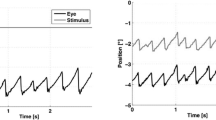Abstract
There are several methods of measuring horizontal, vertical and torsional nystagmus for the diagnosis of vertigo. Using Frentzel glasses, electronystagmography (ENG) and video-oculography (VOG) are common methods for observing nystagmus. In this study, a high-speed video camera is used to analyse high-speed eye movements, including three components of nystagmus, in order to monitor precisely the amplitude and velocity of the quick phase of nystagmus. To confirm the accuracy of the analysis, images of optokinetic nystagmus (OKN) evoked by a stimulating device were analysed. We obtained a high linearity with regard to the relation between the horizontal nystagmus amplitude detected with the high-speed video system and ENG (R2=0.99). On comparison of the maximum velocities detected with 30 Hz and with 250 Hz at each amplitude, the velocities calculated at 30 Hz were smaller than those calculated at 250 Hz. At an amplitude of 5°, the 30 Hz velocity decreased by 50%, while a decrease of 35% was observed at 15°. The vertical nystagmus data obtained using high-speed VOG was different in appearance to that obtained using ENG. The torsional component of nystagmus was also measured, and was recorded in the form of a large number of sampling points.
Similar content being viewed by others
References
Arden, G. B., andKelsey, J. H. (1962): ‘Changes produced by light in the standing potential of the human eye’,J. Physiol.,161, pp. 189–204
Baloh, R. W., Konrad, H. R., Sills, A. W., andHonrubia, V. (1975): ‘The saccade velocity test’,Neurol.,25, pp. 1071–1076
Bentley, C. R., Bronstein, A. M., Faldon, M., Farmer, S., Gresty, M. A., Matthews, T. D., Paine, M., Plant, G. T., andRiordan-Eva, P. (1998): ‘Fast eye movement initiation of ocular torsion in mesodiencephalic lesions’,Ann. Neurol.,43, pp. 729–737
Bradly, A., Abdul Rahman, H., Soni, P. S., andZhang, X. (1993): ‘Effects of target distance and pupil size on letter contract sensitivity with simultaneous vision bifocal contact lenses’,Optom. Vis. Sci.,70, pp. 476–481
Collewijn, H., van der Mark, F., andJansen, T. C. (1975): ‘Precise recording of human eye movements’,Vison. Res.,15, pp. 447–450
Fetter, M., andSievering, F. (1995): ‘Three-dimensional eye movement analysis in benign paroxysmal positioning vertigo and nystagmus’,Acta Otolaryngol. (Stockh.),115, pp. 353–357
Grimby, A., andRosenhall, U. (1995): ‘Health-related quality of life and dizziness in old age’,Gerontol.,41, pp. 286–298
Hopf, H. C. (1987): ‘Vertigo and masseter paresis. A new local brainstem syndrome probably of vascular origin’,J. Neurol.,235, pp. 42–45
Ishikawa, N., Kobayashi, N., Hosaka, H., Morizono, T., Yamanobe, S., Yagi, T., andKatayama, K. (1995): ‘Development of a new examination system for vertigo—Three dimensional analysis of eye movements by an iris striation tracking method’,Jap. J. Med. Elec. Bio. Eng.,33, pp. 192–202
Juhola, M., Jantti, V., andPyykko, I. (1985): ‘Effects of sampling frequencies on computation of the maximum velocity of saccadic eye movements’,Biol. Cybern.,53, pp. 67–72
Kenyon, R. T. (1985): ‘A soft contact lens search coil for measuring eye movements’,Vison. Res.,25, pp. 1629–1633
Kris, C. (1958): ‘Corneo-fundal potential variations during light and dark adaptation’,Nature,182, pp. 1027–1028
Ogino, S., Kato, I., Sakuma, A., Takahashi, K., andTakeyama, I. (1996): ‘Vertical optokinetic nystagmus in normal individuals’,Acta Otolaryngol. (Stockh.),Suppl 522, pp. 32–42
Pyykko, I., Herniksson, N. G., Wennmo, C., andSchalen, L. (1981): ‘Velocity of rapid eye movements and vertigo of central organ’,Ann. Otol. Rhinol. Laryngol.,90, pp. 164–168
Robinson, D. A. (1963): ‘A method of measuring eye movement using a search coil in a magnetic field’,IEEE Trans., BME-10, pp. 137–145
Robinson, D. A. (1964): ‘The mechanics of human saccadic eye movements’,J. Physiol.,174, pp. 245–264
Ron, S., Robinson, D. A., andSkavenski, A. A. (1972): ‘Saccades and quick phase of nystagmus’,Vison. Res.,12, pp. 2015–2022
Scherer, H., Teiwes, W., andClarke, A. H. (1991): ‘Measuring three dimensions of eye movement in dynamic situations by means of videooculography’,Acta Atolaryngol.,111, pp. 182–187
Shakel, B. (1967): ‘Eye movement recording by electro-oculography’in Venables, D. H., andMartin, I. (Eds): Manual of psychophysiological methods’ (North-Holland, Amsterdam), pp. 299–334
Sloane, P., Blazer, D., andGeriatr, L. K., (1989): ‘Dizziness in a community elderly population’,J. Am. Geriatr. Soc.,37, pp. 101–108
Weindruch, R., Koper, S. P., andHadley, E. (1989): ‘The prevalence of dysequilibrium and related disorders in older person’,Ear Nose Throat J.,68, pp. 925–929
Yagi, T., Kurosaki, S., Yamanobe, S., andMorizono, T. (1992): ‘Three-component analysis of caloric nystagmus in human’,Arch. Otolaryngol. Head Neck Surg.,118, pp. 1077–1080
Yagi, T., andUshio, K. (1995): ‘Nystagmus in benign paroxysmal positional vertigo: A three-component analysis’,Acta Otolaryngol. (Stockh.),Suppl520, pp. 283–240
Yagi, T., Ohyama, Y., Suzuki, K., Kamura, E., andKokawa, T. (1997): ‘3D analysis of nystagmus in peripheral vertigo’,Acta Otolaryngol. (Stockh.),117, pp. 135–138
Author information
Authors and Affiliations
Corresponding author
Rights and permissions
About this article
Cite this article
Iijima, A., Minamitani, H. & Ishikawa, N. Image analysis of quick phase eye movements in nystagmus with high-speed video system. Med. Biol. Eng. Comput. 39, 2–7 (2001). https://doi.org/10.1007/BF02345259
Received:
Accepted:
Issue Date:
DOI: https://doi.org/10.1007/BF02345259




